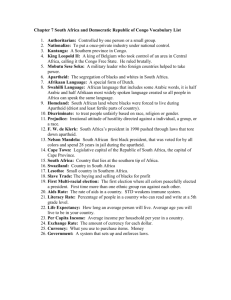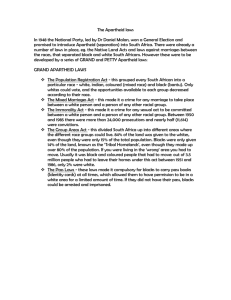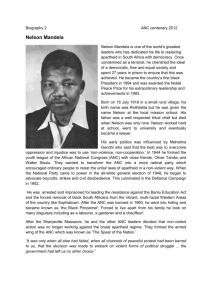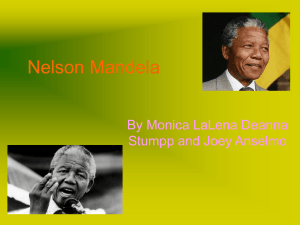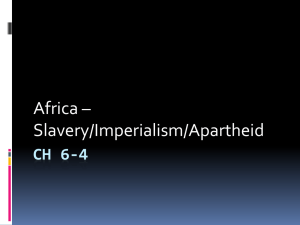South Africa: Resistance and End to Apartheid
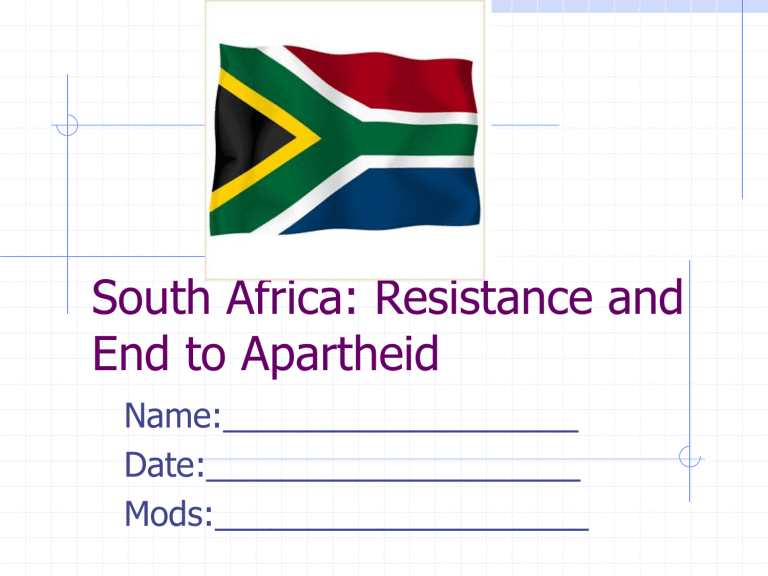
South Africa: Resistance and
End to Apartheid
Name:___________________
Date:____________________
Mods:____________________
What we need to know…..
People in Societies
Cultures 1. Analyze examples of how people in different cultures view events from different perspectives including: d. End of Apartheid in South Africa
End of Apartheid
Apartheid: meaning “apartness”, was the system used by the South African government to exploit and dominate the country’s black population.
Racial Segregation: From 1948-1994
Goal of Apartheid: Keep whites and blacks apart so that whites could control Africa’s wealth.
How was Apartheid achieved?
Although apartheid can be traced back to the colonization of the British it did not become law until 1948.
1948 elections, the National Party campaigned for the Apartheid Laws
Practice of Apartheid
1. Legislation passed prohibiting miscegenation (mixed-race marriage.)
2. Individuals were classified into different ethnic groups:
-White
-Black
-Asian
-Coloured (mixed race)
3. The Groups Area Act: 1950 designed to geopgraphically separate the racial groups.
Homelands
The Black majority were forced to live in
“homelands” that were largely without plumbing or electricity
Blacks would no longer be citizens of South
Africa; rather they would become citizens of independent “homelands”.
About 13% of the land was divided into 10 homelands for blacks- 80% of the population
Homelands prevented non-white people from having a vote.
Separate but Equal? HARDLY!
Education, medical care, and other public services were sometimes claimed to be separate but equal, but those available to non-white people were inferior
Blacks could not live or work in white areas unless they had a pass-nicknamed dompas
(dumb pass in Afrikaans)
Apartheid Laws
Trains and buses were segregated.
Public beaches, libraries, swimming pools were racially segregated
Black people were not allowed to employ white people
Black police were not allowed to arrest whites
Cinemas and theaters in “white areas” were not allowed to admit blacks.
Taxis, graveyards, parks, pedestrian crossings, public toilets were also segregated
Passbooks
Blacks and coloureds had to carry identity documents, which prevented them from migrating to white South
Africa.
Blacks were prohibited from living in or visiting ‘white towns’
The International Community
The United Nations and the
International Criminal Court defined
Apartheid as a “crime against humanity” at a convention in 1976.
The African National Congress(ANC) began to take action
The ANC
They advocated open resistance in the form of strikes, acts of public disobedience, and protest marches
They adopted a Freedom charter, which had a vision of non-racial democratic state
The Sharpeville Massacre
A group of ANC members broke away from the white government and formed the more militant Pan Africanist Congress (PAC)
They wanted to have a series of nationwide demonstrations against the apartheid laws.
In 1960, they gathered in a township called
Sharpeville to protest against the ID cards.
The crowd converged on the local police station, singing and offering themselves up for arrest for not carrying their passbooks.
Sharpeville Massacre cont.
A group of 300 police opened fire on the demonstrators, killing 69 and injuring 186.
All victims were black and most had been shot in the back
The government then banned ANC and the PAC
Resistance Underground
The ANC decided to take up armed resistance to the government
They still had peaceful protests, but also took on terrorist tactics, such as intimidation, bombing, murder and sabotage
The Prime Minister declared a state of emergency and forces could detain people without a trial.
Over 18,000 demonstrators were arrested, including many leaders of the ANC and PAC
Together with ANC leader Nelson Mandela, they were charged with treason in 1964 and sentenced to life imprisonment.
Resistance
The trial condemned by the UN Security
Council and the international community started to force sanctions against the South
African Government
For example, they banned trade, which was an economic saction.
Sports teams were banned from international competition
Tourism was boycotted
Black Consciousness
Movement
Steve Biko and South African Students; Organization stressed the need for liberation, black pride and non-violent resistance
In 1974, the government state that all black schools would use the
Afrikaans language for instruction
In 1976, students at Orlando West Junior School in Soweto went on strike, refusing to go to school
Their protest spread to other schools and there was a mass rally, which turned violent.
Police responded with bullets to stones thrown by the students
The official death toll was recorded as 23, but some say it was as high as 200.
Photo of Sowento Riots showing a student carrying the body of Hector Pieterson, one of the first casualties
How did South Africans resist apartheid
Through civil disobedience, strikes, boycotts, nonviolent demonstrations, armed struggle, and calling on the international community to divest
(withdraw investments) from South
Africa.
State of Emergency 1986-1990
1986, the South African government decided that the antiapartheid movement was threatening all-white rule and cracked down on resistance.
The government used mass arrests, torture, and rigged trials to crush opposition.
More than 20,000 people were arrested.
Resistance increased despite the harshness of the state of emergency.
Change of Leadership?
Faced with increased resistance at home and international pressure, the
South African government began to discuss change with the leaders of the antiapartheid movement.
ANC (African National
Congress)
In 1990 the government legalized the
ANC, South Africa’s largest antiapartheid party.
The government released the the ANC party’s leaders from prison.
In 1991 negotiations between the government and antiapartheid leaders began.
F.W. Clerk, South African
President meets with
Nelson Mandela, leader of the
ANC.
Nelson Mandela
Nelson Mandela was released from prison after serving 30 years for resisting apartheid.
Mandela was symbolic as the leader of antiapartheid resistance.
Culmination of Resistance: A
True Democracy in South
Africa
The South African government agreed to hold all-party elections in 1994.
Elections began April 27, 1994 and lasted for 5 days.
Many voters traveled more than a day to reach the polls.
Some waited in lines for 24 hours to vote for the first time in their lives.
April 1994 Election Results
The ANC won 63% of the 20 million votes cast
Nelson Mandela elected as South
Africa’s first African president.
By May 1996 the ANC and other South
African parties agreed to write a new constitution
New Challenges for South
Africa
Country still suffered from economic inequality
1996, the majority of the money, property and high level jobs were still in the hands of the white minority


